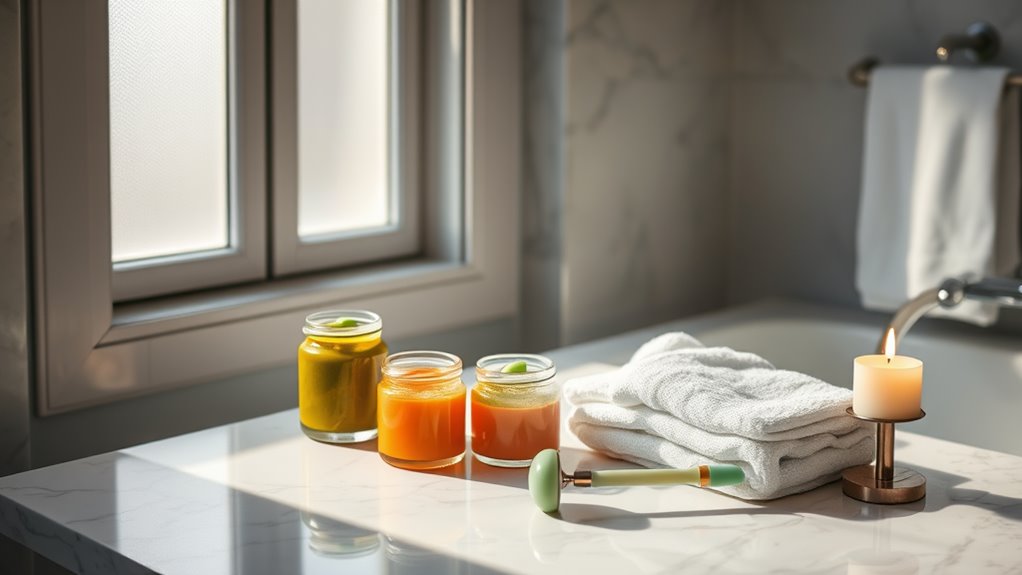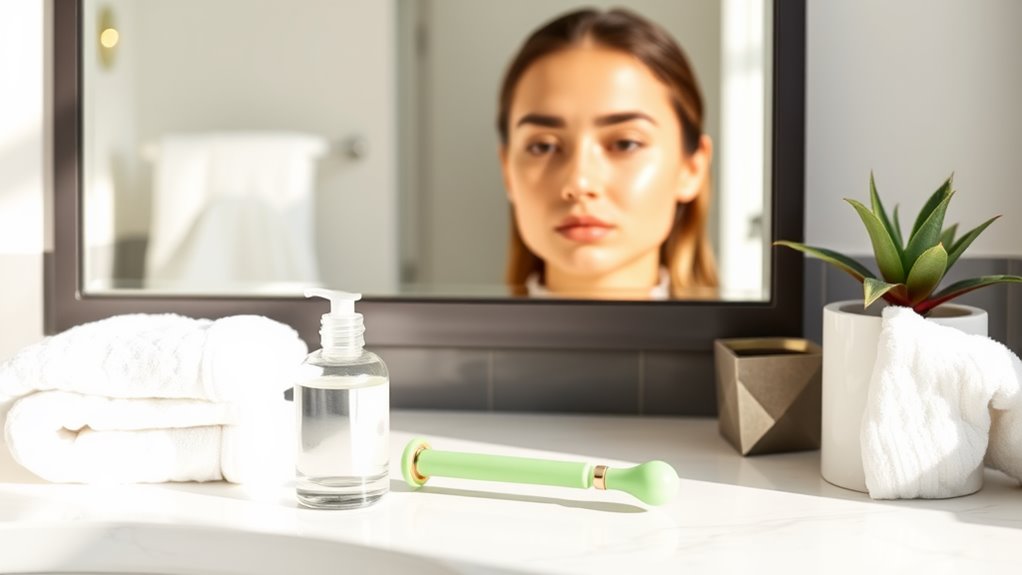Weekend Face Mask Routine That Resets Your Skin
For a weekend face mask routine that resets your skin, start by choosing a mask suited to your skin type—clay for oily skin or hydrating formulas for dryness. Prep your skin by cleansing and exfoliating, then apply the mask evenly. Focus on relaxation while it works its magic. After removing the mask, follow up with moisturizer to lock in hydration. These steps can rejuvenate your complexion, and there’s more to discover for lasting results.
Key Takeaways
- Start with a thorough cleanse and gentle exfoliation to remove impurities and dead skin cells for a fresh canvas.
- Choose a face mask suitable for your skin type—hydrating for dry skin, clarifying for oily skin, or calming for sensitive skin.
- Apply the mask using upward strokes for better absorption and to promote circulation, focusing on problem areas.
- After the mask, follow up with a nourishing moisturizer to lock in hydration and maximize the mask’s effects.
- Maintain a weekend routine with consistent cleansing, hydration, and sun protection throughout the week for optimal skin health.
Choosing the Right Face Mask for Your Skin Type
When you’re selecting a face mask, it’s essential to take into account your skin type so you can achieve the best results.
If you’ve got oily skin, opt for a clay or charcoal weekend mask to absorb excess oil and unclog pores.
For dry skin, rich hydrating masks with ingredients like hyaluronic acid or aloe vera work wonders, restoring moisture and elasticity.
If your skin is sensitive, choose a calming mask with soothing ingredients like chamomile or oatmeal.
Combination skin can benefit from a targeted approach: apply a clarifying mask on oily areas and a hydrating one on dry patches.
Always read the labels to verify compatibility with your skin’s unique needs, maximizing your weekend mask experience. Additionally, consider incorporating customization tips to further enhance your results based on your skin’s response.
Prepping Your Skin for Maximum Absorption
How can you guarantee your skin gets the most out of your weekend face mask? Start by cleansing your face thoroughly to remove dirt, oil, and makeup.
Use a gentle exfoliator to slough off dead skin cells, enhancing absorption. This step preps your skin, allowing the active ingredients in your mask to penetrate more deeply.
Follow up with a warm towel or steam to open your pores; this creates the perfect environment for absorption. Incorporating double cleansing techniques can ensure that your skin is properly cleansed and ready for the mask.
Don’t forget to hydrate your skin with a light moisturizer before applying your mask. Keeping your skin well-hydrated ascertains it’s primed for maximum benefits.
Application Techniques for Best Results
With your skin prepped and ready, the next step is applying your face mask effectively for the best results.
Start by using clean fingers or a brush to evenly distribute the mask across your face, avoiding the eye and lip areas. Apply in upward strokes to promote blood circulation and lift.
Focus on areas that need extra attention, like your T-zone or dry patches. Don’t overload; a thin, even layer allows for ideal absorption.
Make sure to use gentle pressure, as aggressive application can irritate your skin.
Finally, take a moment to enjoy the process—relax and breathe deeply, as this enhances both your experience and the mask’s effectiveness. Incorporating a weekend face mask routine can lead to significant improvements in your skin’s texture and appearance.
Master these techniques for a rejuvenated complexion.
Recommended Timing for Each Mask
When choosing the right time for your face masks, consider the unique benefits each one offers. Morning masks can energize and prep your skin for the day, while evening masks help with recovery and hydration overnight. You should also think about how often you want to treat your skin, as consistency is key for achieving the best results. Incorporating simple skincare rituals into your routine can further enhance the effectiveness of your masks.
Morning Mask Benefits
Starting your day with a morning face mask can transform your skincare routine and enhance your skin’s health. By incorporating a mask specifically designed for morning use, you can awaken your complexion and prepare your skin for the day ahead.
Look for masks that hydrate, brighten, or energize—these will give your skin that coveted glow. Ideally, apply your mask after cleansing and before your moisturizer, allowing the active ingredients to penetrate effectively.
Aim for a 10-15 minute application time to maximize benefits without feeling rushed. This quick ritual not only boosts your skin’s appearance but also sets a positive tone for your day, reminding you to prioritize self-care amidst your busy schedule.
Embrace this powerful morning habit!
Evening Mask Routine
As your day winds down, incorporating an evening face mask into your routine can greatly enhance your skincare regimen. Timing is key to maximizing benefits, so here’s a simple guide to follow:
| Mask Type | Recommended Timing | Key Benefits |
|---|---|---|
| Hydrating Mask | 7 PM – 8 PM | Restores moisture |
| Purifying Mask | 8 PM – 9 PM | Draws out impurities |
| Anti-Aging Mask | 9 PM – 10 PM | Promotes skin renewal |
| Calming Mask | 10 PM – 11 PM | Soothes and relaxes skin |
Frequency of Application
Finding the right frequency for applying face masks can elevate your skincare routine considerably.
For best results, aim to use a hydrating mask once a week. This frequency allows your skin to absorb moisture without overwhelming it.
Exfoliating masks, on the other hand, work best every two weeks. They help remove dead skin cells, promoting a smoother texture without causing irritation.
If you’re targeting specific concerns, like acne or pigmentation, consider a treatment mask once a week, but listen to your skin’s needs.
Always assess how your skin responds; it may require adjustments based on seasonal changes or stress levels.
Mastering the timing of each mask not only enhances effectiveness but also transforms your skin into a healthier canvas.
Incorporating Exfoliation Into Your Routine
While you might already have a cleansing and moisturizing routine in place, incorporating exfoliation is essential for achieving that radiant weekend glow. Exfoliation removes dead skin cells, unclogs pores, and boosts cell turnover, revealing fresh, luminous skin beneath.
Aim to exfoliate 1-2 times a week, using either a physical scrub or a chemical exfoliant, depending on your skin type and sensitivity. When you exfoliate, be gentle; aggressive scrubbing can irritate your skin. Consider incorporating this step before your face mask for ideal absorption of nutrients. Adding natural DIY face masks to your routine can enhance your skin’s glow even further by providing essential nutrients and hydration.
Post-Mask Care to Lock in Benefits
After you’ve enjoyed your face mask, hydration is essential to lock in those benefits.
Make sure to follow up with a good moisturizer to seal in moisture and keep your skin glowing.
This step will help maintain the effects of your mask and leave your complexion looking fresh.
Hydration Is Key
To maximize the benefits of your weekend face mask routine, hydrating your skin afterward is essential. After removing the mask, your skin craves moisture to seal in the nutrients. Consider these hydration strategies:
| Hydration Method | Benefits | Recommended Products |
|---|---|---|
| Hydrating Serum | Deep penetration | Hyaluronic acid serum |
| Moisturizing Cream | Locks in moisture | Rich, emollient cream |
| Facial Mist | Instant refresh | Aloe vera or rose water mist |
| Sheet Mask | Boosts hydration | Collagen-infused sheet masks |
| Overnight Mask | Overnight recovery | Hydrating gel or cream mask |
Follow-Up Moisturizer Steps
Once you’ve hydrated your skin post-mask, it’s time to lock in those benefits with the right follow-up moisturizer steps.
Start by choosing a moisturizer that complements your skin type—opt for a lightweight gel if you’re oily or a rich cream if you’re dry. Apply the moisturizer while your skin is still slightly damp to seal in hydration effectively.
Don’t forget to massage it in using upward motions, promoting circulation and deeper absorption. If you’re feeling extra indulgent, consider a facial oil for added nourishment.
Finish off with a sunscreen if you’re heading out, as protecting your refreshed skin is essential.
Tips for Maintaining Healthy Skin Throughout the Week
While weekends are perfect for indulging in a rejuvenating face mask, maintaining healthy skin throughout the week requires consistent care and attention.
Start by cleansing your skin morning and night to remove impurities and excess oil. Don’t skip sunscreen—even on cloudy days—since UV rays can cause long-term damage.
Incorporate a serum rich in antioxidants to combat free radicals and promote a radiant complexion. Stay hydrated by drinking plenty of water, and consider adding a humidifier to your environment for added moisture.
Exfoliate gently a couple of times a week to slough off dead skin cells and encourage cell turnover.
Finally, always listen to your skin; if it feels irritated, adjust your routine accordingly. Consistency is key for mastery!
Frequently Asked Questions
How Often Should I Do a Weekend Face Mask Routine?
You should aim for a weekend face mask routine once a week. This frequency allows your skin to benefit from revitalization without overwhelming it, promoting balance and enhancing its overall health and appearance effectively.
Can I Use Multiple Masks in One Session?
Yes, you can absolutely use multiple masks in one session! Just make certain each mask targets different skin concerns, and apply them in the right order to maximize benefits. Your skin will appreciate the tailored approach!
Are DIY Face Masks Effective Compared to Store-Bought?
DIY face masks can be effective, but their results often depend on your skin type and ingredients. Store-bought masks offer convenience and formulation consistency, so choose based on your specific needs and desired outcomes.
What Ingredients Should I Avoid in Face Masks?
You should avoid harsh chemicals like alcohol, synthetic fragrances, and parabens in face masks, as they can irritate your skin. Instead, opt for gentle, natural ingredients that nourish and protect your complexion effectively.
How Can I Tell if a Mask Is Irritating My Skin?
To determine if a mask irritates your skin, watch for redness, itching, or burning sensations. If you notice any of these signs, it’s best to remove the mask immediately and avoid using it again.





